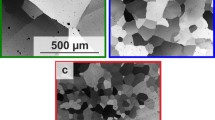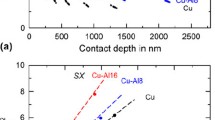Abstract
Monotonic compression and stress relaxation tests were carried out on specimens of 6 cast binary alloys with (at. pct) 2.5 Al, 0.6 Sn, 2.2 Zn, 0.9 Nd, 0.8 Gd and 1.3 Y, and of a similarly cast AZ91D alloy for reference. The solute concentration of the binary alloys was kept deliberately low to limit precipitation hardening effects during the testing, done in the solution heat treated and quenched condition. Compression testing was carried out at 298 K, 373 K and 453 K (25 °C, 100 °C and 180 °C) for all of the alloys and at 493 K and 523 K (220 °C and 250 °C) for the Nd-, Gd- and Y- containing ones. Stress relaxation was done at 453 K (180 °C) at either a predetermined strain (0.05) or stress (150 MPa). The Mg-Al and the AZ91 alloys softened considerably above 373 K (100 °C). The rest of the alloys exhibited increasing linear strain hardening in compression and reduced stress relaxation, in the order Sn, Zn, Nd, Gd and Y, an indication of a progressively stable dislocation substructure, hence of an increasingly extended athermal regime in the strength-temperature relationship. The overall strain hardening behavior matches that of commercial alloys involving the same solutes at comparable or higher concentrations, and can be accounted for through the respective tendency of the solute atoms to develop short range order. This tendency is lowest for the near-random solid solution introduced by Al, and highest for Nd, Gd and Y, in agreement with their respective phase diagrams. The implications for creep resistant alloy selection and design are discussed.






Similar content being viewed by others
Notes
Strain hardening[22,24] due to the monotonic accumulation of dislocations when the obstacles are fixed in number and distance, e.g. grain boundaries, leads to parabolic hardening. Alternatively, when the spacing between obstacles decreases in proportion to the applied strain, e.g. through the densification of the forest of dislocations, the strain hardening is linear, with a gradient of about µ/200, where µ is the shear modulus. The former case accounts for a Hall–Petch type of hardening when the main obstacles are grain boundaries. The second case accounts for the linear hardening in stage II of deformation of single crystals at low temperatures, i.e. when, poly-slip is activated in polycrystals under conditions in which dynamic recovery is constrained (i.e. at sufficiently low temperatures).[25] The specific case of linear strain hardening of Mg polycrystals was discussed at length in Reference 23.
See also the comments concerning Eq. [3] in the companion paper.[16]
References
J.R. Terbush, N.D. Saddock, J.W. Jones, T.M. Pollock, Metallurgical and Materials Transactions A, 41 (2010) 2435-2442.
[2] J.-F. Nie, Metallurgical and Materials Transactions A, 43 (2012) 3891-3939.
[3] B.L. Mordike, Materials Science and Engineering A, 324 (2002) 103-112. http://dx.doi.org/10.1016/S0921-5093(01)01290-4
[4] M.O. Pekguleryuz, A.A. Kaya, Advanced Engineering Materials, 5 (2003) 866-878.
M. Pekguleryuz, M. Celikin, International Materials Reviews, 55 (2010) 197-217. http://dx.doi.org/10.1179/095066010X12646898728327
[6] M.S. Dargusch, G.L. Dunlop, A.L. Bowles, K. Pettersen, P. Bakke, Metallurgical and Materials Transactions A, 35 (2004) 1905-1909.
K. Maruyama, M. Suzuki, S. Hiroyuki, Metallurgical and Materials Transactions A, 33 (2002) 875-882.
[8] I. Moreno, T. Nandy, J. Jones, J. Allison, T. Pollock, Scripta Materialia, 45 (2001) 1423-1429.
[9] M.A. Gibson, X. Fang, C.J. Bettles, C.R. Hutchinson, Scripta Materialia, 63 (2010) 899-902. http://dx.doi.org/10.1016/j.scriptamat.2010.07.002
[10] S.M. Zhu, M.A. Gibson, M.A. Easton, J.F. Nie, Scripta Materialia, 63 (2010) 698-703. http://dx.doi.org/10.1016/j.scriptamat.2010.02.005
[11] K.V. Yang, M.A. Easton, C.H. Caceres, Advanced Engineering Materials, 15 (2013) 302-307. http://dx.doi.org/10.1002/adem.201200188
[12] B. Zhang, S. Gavras, A.V. Nagasekhar, C.H. Cáceres, M.A. Easton, Metallurgical and Materials Transactions A, 45 (2014) 1-12. http://dx.doi.org/10.1007/s11661-014-2416-9
[13] T.L. Chia, M.A. Easton, S.M. Zhu, M.A. Gibson, N. Birbilis, J.F. Nie, Intermetallics, 17 (2009) 481-490. 10.1016/j.intermet.2008.12.009
[14] K. Yang, C. Cáceres, M. Easton, Metallurgical and Materials Transactions A, 45 (2014) 4117-4128. http://dx.doi.org/10.1007/s11661-014-2326-x
[15] B. Zhang, A.V. Nagasekhar, X. Tao, Y. Ouyang, C.H. Cáceres, M. Easton, Materials Science and Engineering: A, 599 (2014) 204-211.
S. Abaspour, C. Cáceres, Metallurgical and Materials Transactions A, 46 (2015) 5972-5988. http://dx.doi.org/10.1007/s11661-015-3128-5
S. Abaspour and C. Cáceres: in Magnesium Technology, M. Alderman, M.V. Manuel, N. Hort, and N.R. Neelameggham, eds., The Minerals, Metals & Materials Society (TMS), San Diego, 2014, pp. 71–75.
S. Abaspour and C.H. Caceres: in Magnesium Technology, N. Hort, S.N. Mathaudhu, N.R. Neelameggham, and M. Alderman, eds., The Minerals, Metals & Materials Society (TMS), San Antonio, 2013, pp. 17–20.
[19] G.-w. Chang, S.-y. Chen, C. Zhou, X.-d. Yue, Y.-h. Qi, Transactions of Nonferrous Metals Society of China, 20 (2010) 289-293. http://dx.doi.org/10.1016/S1003-6326(09)60136-9
[20] C.H. Caceres, G.E. Mann, J.R. Griffiths, Metallurgical and Materials Transactions A, 42 (2011) 1950-1959. http://dx.doi.org/10.1007/s11661-010-0599-2
[21] S. Xu, M.A. Gharghouri, M. Sahoo, Advanced Engineering Materials, 9 (2007) 807-812.
[22] D. Kuhlmann-Wilsdorf, Metallurgical and Materials Transactions, 35A (2004) 369-418.
[23] C.H. Cáceres, P. Lukác, Philosophical Magazine A, 88 (2008) 977-989. http://dx.doi.org/10.1080/14786430801968611
[24] U.F. Kocks, H. Mecking, Progress in Materials Science, 48 (2003) 171-273.
H. Mecking: in Strength of Metals and Alloys (ICSMA-5), P. Haasen, V. Gerold, and G. Kostorz, eds., Pergamon Press, NY, 1979, pp. 1573–94.
[26] H. Suzuki, in: J C Fisher, W G Johnston, R Thomson, T Vreeland (Eds.) Dislocations and mechanical properties of crystals, John Wiley, New York, 1957, pp. 361-390.
[27] K. Sadananda, M.J. Marcinkowski, Journal of Applied Physics, 44 (1973) 1989- 1996. http://dx.doi.org/10.1063/1.1662504
S. Gavras, S. Zhu, M.A. Gibson, M.A. Easton, and J.-F. Nie: in 9th International Conference on Magnesium alloys and their Applications, Karl-Ulrich Kainer Warren J. Poole, ed., Vancouver, 2012, pp. 757–764.
T.J. Pike, B. Noble, Journal of the Less Common Metals, 30 (1973) 63-74. http://dx.doi.org/10.1016/0022-5088(73)90007-6
L. Moreno, T. Nandy, J. Jones, J. Allison, and T. Pollock: in Magnesium Technology, H.I. Kaplan, ed., TMS, 2002, pp. 111–116
[31] Z. Trojanová, P. Lukác, Journal of Materials Processing Technology, 162-163 (2005) 416-421.
[32] S. Zhu, M.A. Easton, T.B. Abbott, J.-F. Nie, M.S. Dargusch, N. Hort, M.A. Gibson, Metallurgical and Materials Transactions A, 46 (2015) 1-12. http://dx.doi.org/10.1007/s11661-015-2946-9
[33] A.A. Luo, B.R. Powell, M.P. Balogh, Metallurgical and Materials Transactions A, 33 (2002) 567-574. http://dx.doi.org/10.1007/s11661-002-0118-1
C.H. Cáceres, and A. Blake: Physica Status Solidi, 194 (a) (2002) 147–158.
[35] R.F. Zhang, B.X. Liu, Applied Physics Letters, 81 (2002) 1219-1221. doi:http://dx.doi.org/10.1063/1.1499510
[36] T. Wang, L. Jiang, R. Mishra, J. Jonas, Metallurgical and Materials Transactions A, 45 (2014) 4698-4709. http://dx.doi.org/10.1007/s11661-014-2371-5
Author information
Authors and Affiliations
Corresponding author
Additional information
Manuscript submitted December 5, 2014.
Rights and permissions
About this article
Cite this article
Abaspour, S., Cáceres, C.H. High Temperature Strength and Stress Relaxation Behavior of Dilute Binary Mg Alloys. Metall Mater Trans A 47, 1313–1321 (2016). https://doi.org/10.1007/s11661-015-3292-7
Published:
Issue Date:
DOI: https://doi.org/10.1007/s11661-015-3292-7




